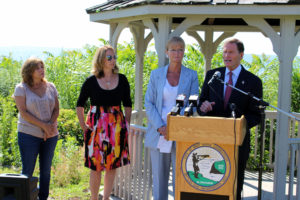
By Michael P. Walsh
Special to the Voice
During a news conference Friday at the Savin Rock gazebo, U.S. Sen. Richard Blumenthal, D-Conn., and Mayor Nancy R. Rossi discussed how an upcoming Senate vote could bring “millions of dollars” in federal aid to the city’s coastline.
In the next three weeks, Blumenthal said, the Senate is poised to vote on the Water Resources Development Act, broad legislation to address the nation’s water infrastructure needs.
West Haven’s shoreline was severely eroded by Superstorm Sandy, making private and public infrastructure vulnerable to future weather events.
Blumenthal and Rossi were joined at the morning announcement by state Rep. Dorinda Borer, D-115, and City Clerk Deborah Collins.
Early last month, Borer heralded $3.9 million in state funding for a new Cove River tide gate system to mitigate flooding and protect the tidal wetland, which abuts the campus of West Haven High School.
During the news conference, Connecticut’s senior senator said he fought for key provisions in the bill benefiting the state, including measures to safeguard West Haven’s beaches from future storm damage.
Blumenthal said the provisions, also supported by U.S. Sen. Chris Murphy, D-Conn., call for the city to receive millions in federal funding to build dunes along the shoreline.
“Dunes are immensely important to the protection of property and life,” Blumenthal said.
The Army Corps of Engineers would oversee the federal project, he said.
“We are taking a multipronged approach to minimize the effect future storms will have on West Haven,” Rossi said. “On a beautiful day like today, it may be difficult to imagine why we are talking about coastal resiliency and storm hazard mitigation, but this is exactly when we should be making plans — not when a serious storm is in the forecast.”
She added: “This afternoon I’ll be meeting with our emergency operations center coordinator and the United Illuminating to discuss how West Haven can be ‘storm smart.’ The Atlantic hurricane season started seven weeks ago today and doesn’t end until Nov. 30. We have to be ready.”
West Haven prides itself on being home to the longest stretch of publicly accessible shoreline in Connecticut. The city’s nearly 4-mile tract of beach on Long Island Sound comprises 25 percent of the state’s public beaches, a valuable asset that is ripe for attracting new businesses to the city, Rossi said.
City grants writer Eileen M. Krugel said the federal funding would finance the construction of beach dunes from the Savin Rock Conference Center on Rock Street to Beach Street and Morse Avenue, a distance of about a mile.
While some beach areas have dunes, particularly along Beach Street, the funding “would provide uniformed dunes that would include protective grasses, fencing and dune crossovers preventing degradation by pedestrians,” Krugel said.
“These dunes would provide a protective measure in West Haven’s resiliency efforts,” said Krugel, adding that the project would complement the new tide gates as part of the city’s Coastal Resilience Plan.
Officials have said the gates are vital to the preservation and restoration of the Cove River tidal wetland. When functioning, they are designed to protect the surrounding infrastructure and restore tidal flushing of the 90-acre marsh without flooding upland property, including homes, businesses and West Haven High, which is undergoing a $134 million reconstruction.
The gates, however, have been deemed “nonfunctioning” for the past 45 years, officials have said.
On Oct. 29, 2012, the surge of Superstorm Sandy overwhelmed the tide gates and flooded the high school’s ballfields and track, prompting city officials to seek state funding to safeguard the area from a similar flooding event.
Officials said the dune project would also complement the $14.5 million reconstruction of a section of Beach Street and First Avenue that was 5 feet underwater during Sandy.
The federal and state project, originally estimated at $8.5 million, has increased by $6 million because soil tests showed a subsurface of peat, Krugel said.
The project includes raising a 4,000-foot stretch of First Avenue and Beach Street from Monahan Place, near the wastewater treatment plant, to Morse Avenue, near the former Chick’s Drive-in restaurant.
Elevations will range from 2 to 5 feet, based on existing topography, City Engineer Abdul Quadir has said.
During Sandy, the Water Pollution Control Plant, 2 Beach St., was inaccessible to staff and emergency vehicles for nearly 12 hours because of extensive flooding.
In the storm’s wake, the city has taken steps to make it more resilient to tidal flooding and coastal storms, including dredging the Old Field Creek salt marsh near Beach Street, thanks to federal funding to help Connecticut municipalities like West Haven make such improvements.
The raising of Beach Street is being paid for in part by the U.S. Department of Housing and Urban Development’s Community Development Block Grant Disaster Recovery program.
The project also includes the construction of concrete sidewalks and a two-way bike lane for future connection to a regional shoreline bikeway system, Assistant City Planner David W. Killeen has said.